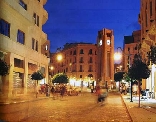| Random image |
 |

Downtown Beirut
|
 |
|
 |
 |
ANJAR
This 8th century Islamic city was discovered and identified in the
early 1950s. Anjar was built by the Damascus-based
Umayyad rulers around 660-750 AD. The site is not alike
other sites in Lebanon belonging to different epochs, but
only to the Ummayad.
Anjar is a unique historical example of an inland commercial
center, benefiting from a strategic position on intersecting
trade routes leading to Damascus, Homs, Baalbeck and to the
South. The ruins lie amidst some of the richest agricultural
land in Lebanon and is one of the important sources of the
Litani River.
Along both sides of the streets there are evenly spaced
columns that were one parts of an arcade. The great or main
palace itself was the first landmark to emerge in 1949 when
Anjar was discovered. To the north of the palace are the
sparse remains of a mosque, the second palace much finer and
more intricate engravings , rich in motifs borrowed from the
Greco-Roman tradition.
The 114,000 square-meter site has graceful arches, intricate
carvings and symbols suggesting that the architects of Anjar
followed Roman-Byzantine traditions. The two main avenues
connecting the city gates, from east to west and north to
south, divided the town into four quarters. Both avenues
were lined with mosques, baths, livestock pens, palaces and
residences.
The Ruins
The Grand Palace was the first landmark to emerge in 1949
when the site was first discovered.
The palace encloses a 40-square meter courtyard dividing the
palace into two identical parts, one of which has now been
partially reconstructed. Just to the north of the first
palace is a ruined mosque originally constructed on the side
of a yet older and larger one on the northern side of this
same east-west avenue lies another palace. The ruins of
Anjar, the Omayyad town which bestrides a road in the Beqaa,
against a background of mountains may stir in his
imagination echoes of the Thousand and One nights.
On either side of the avenues of the site stand the columns
of a graceful arcade with a large number of shops sheltered
under its arches. These columns are different both in size
and form, Roman influence can be seen in them as well as
Byzantine craftsmen, as was the custom of the time. The main
features of Arab architecture, however, predominate. The two
major avenues mark out the four main areas of the town with
its mosques and public baths, depots for stocking food,
common residences and two striking palaces. The first
discovery unearthed from the stand s of Aanjar was one of
these palaces lying on the south side of the main east west
avenue.
Numerous shops suggest that Anjar served as a commercial
center. Near the archaeological site is an oasis of springs
which provide an idyllic setting for Anjar's restaurants.
Fresh trout and Armenian specialties are among the most
popular items.
|